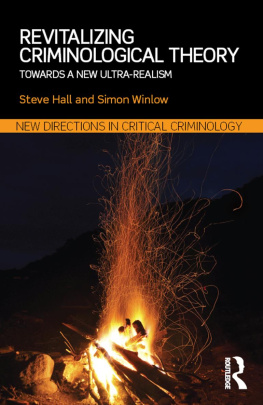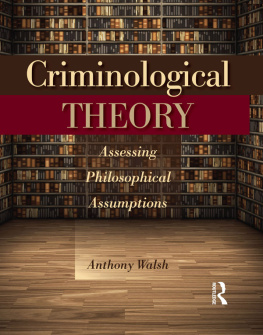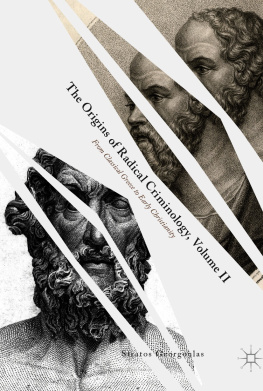Criminology: Explaining Crime and Its Context, Seventh Edition
Copyright 1991, 1996, 1998, 2001, 2004, 2007, 2010
Matthew Bender & Company, Inc., a member of the LexisNexis Group
New Providence, NJ
ISBN-13: 978-1-4224-6332-1
Phone 877-374-2919
Web Site www.lexisnexis.com/anderson/criminaljustice
All rights reserved. No part of this book may be reproduced in any form or by any electronic or mechanical means, including information storage and retrieval systems, without permission in writing from the publisher.
LexisNexis and the Knowledge Burst logo are trademarks of Reed Elsevier Properties, Inc.
Anderson Publishing is a registered trademark of Anderson Publishing, a member of the LexisNexis Group
Brown, Stephen E.
Criminology: explaining crime and its context -- 7th Ed. / Stephen E. Brown, Finn-Aage Esbensen, Gilbert Geis
Includes bibliographical references and index.
ISBN 978-1-4224-6332-1 (softbound)
Library of Congress Control Number: 2010923132
Cover design by Tin Box Studio, Inc./Cincinnati, Ohio | EDITOR Janice Eccleston |
ACQUISITIONS EDITOR Michael C. Braswell |
To MiSuk, Stephanie, and Cory.
SEB
To Dana, Thor, Heidi, and Eva-Rosa.
FE
In memory of Dolores Tuttle Geis and Robley Elizabeth Geis.
GG
Preface
Our challenge in preparing the seventh edition of Criminology: Explaining Crime and Its Context centered on paring back what, by the sixth edition, had grown into a 600+ page book. It seemed a daunting task to the three of us, as authors, because explaining crime is an expansive charge. There is such an array of information that we feel can strengthen the criminological foundation of our students, yet it needs to be manageable within the structural confines of an academic term. Much to our delight, the theoretical boundaries of criminology have blossomed over the span of this texts evolution. Ergo, it was time to trim back and prioritize our burgeoning content.
We had the good fortune of guidance in this attenuating process from several colleagues who have used this text in their own classrooms. While we bear responsibility for final decisions in the process, we rest assured that the final product is much sounder than it would have been without their guidance. Hearty thanks are extended to the following criminologists:
Karen Booyens | University of Pretoria |
Kimberly Detardo-Bora | Marshall University |
Paul Klenowski | Clarion University of Pennsylvania |
William Lugo | Eastern Connecticut University |
Stephen Tibbetts | California State University - San Bernardino |
Charles Tittle | North Carolina State University |
Throughout the years, our efforts to present the evidence and stimulate critical thought regarding a range of criminological perspectives, both seasoned and emerging, have benefited from the comments of far too many students and colleagues to list. For those who have contributed, we extend hearty thanks. Specifically for their help on this edition, we would like to acknowledge Terrance (T.J.) Taylor at the University of Missouri - St. Louis for his thoughtful comments and camaraderie, as well as Dena Carson and J. Michael Vecchio for their assistance. Thanks also to Diane Christenson, Marilyn Washler, and Patricia Edwards, all at the University of California - Irvine for all of their help.
PART I
Foundations for Criminology
The opening unit of this text provides a foundation for the study of criminology as conceptualized by the authors. The goal is to explore the crime problem, its context, and, especially, the causes of crime. Unfortunately media presentations of crime and efforts to control it present a distorted reality of crime as a simple phenomenon (Anderson et al., 2009). Nothing could be further from the truth; understanding crime is far from a simple task. To the contrary, it is extremely complex and challenging. The subtitle of this text, explaining crime and its context, summarizes that premise. It is the goal of this book to delineate the complex context in which crime emerges. Crime can only be understood by considering the broad social context from which it emanates.
Theories or more simply, explanations of crime, serve as the central thesis. While many criminologists do more than develop theories of crime, it is those explanations that provide the foundation for all other criminological endeavors. Predicting criminality and policy development should logically be rooted in some explanatory framework. This text examines a number of frameworks for explaining crime and, therefore, is suggestive of many strategies for addressing it.
In defining crime and criminology, these initial chapters draw attention to three important issues that should be kept in mind throughout the remainder of the book. First is the relativity of crime. What is considered a crime varies by time, place, and who is doing the defining. Examination of crime in the context of diverse cultures from around the world illustrates, perhaps most vividly, the importance of the concept of relativity in understanding crime and deviance. In that sense criminology is inherently cross-cultural. While the focus within the book is more on U.S. criminological thought, material from a range of cultures is included to bolster a broader understanding of crime, deviance and social control. It turns out that the relativity of crime is a fruitful concept for understanding the continual redefinition of crime within our own cultures.
Anderson, J.F., N.J. Mangels & A.H. Langsam (2009). The Challenges of Teaching Criminological Theory: Can Academia Deliver What the Media Promises? Criminal Justice Studies, 22:223-236.
discusses criminology as the scientific study of the causes of crime. Most of the explanations for crime examined within this text, as well as tests of their validity, are based on scientific research. While some coverage is extended to alternative approaches to knowledge about crime, the emphasis on scientific study reflects the scholarly emphasis of the field.
Finally, the impact of ideology on explanations of crime and on crime policy is a cornerstone of this book. A conscious effort has been made to highlight the role of ideology by presenting a wide range of explanations of crime rooted in five dominant paradigms, as well as emerging perspectives on crime. The intent is to offer a balanced perspective on the field of criminology, while obviating neglect of gender subordination, violent white-collar crime, family violence, and other socially harmful behaviors that are often excluded from examination.
1
Crime and Criminology
Crime and criminals capture the attention of nearly everyone. The public fascination with these matters has not escaped the news and entertainment media. The large following of On the Record with Greta Van Susteren, aired on Fox News Network, and the Nancy Grace show, carried by Cable News Network, reflect the widespread fascination with these topics. Sometimes people romanticize criminals so that outlaws like Robin Hood and Jesse James become folk heroes. Other criminals, or alleged offenders, are demonized and become outlets for anger, fear and other emotions. In yet other scenarios, those claiming to be victims are vilified.
At the heart of this fascination with crime-related issues lay some intriguing questions: Why do people commit these crimes? How should we respond? Why is one behavior a crime and not some other behavior? We might exclaim about some outrageous but legally permissible behavior: There oughtta be a law! While the public is intrigued, criminologists address these issues in a more systematic manner. A
Next page




